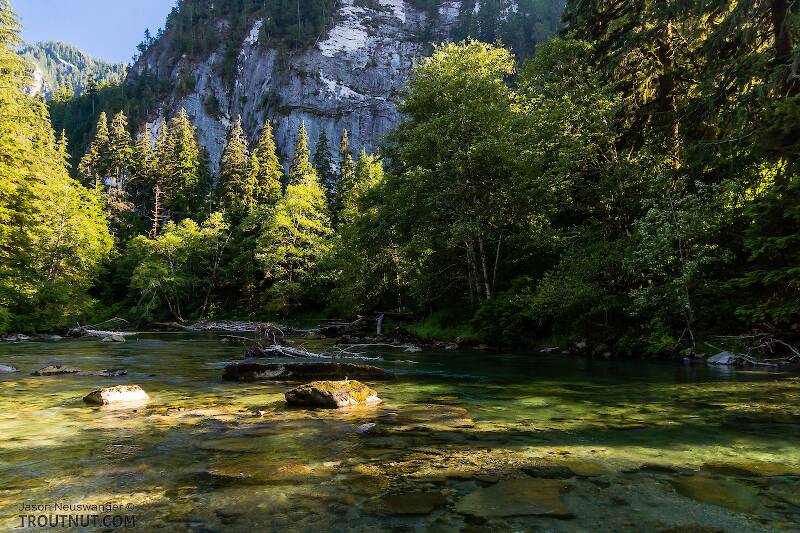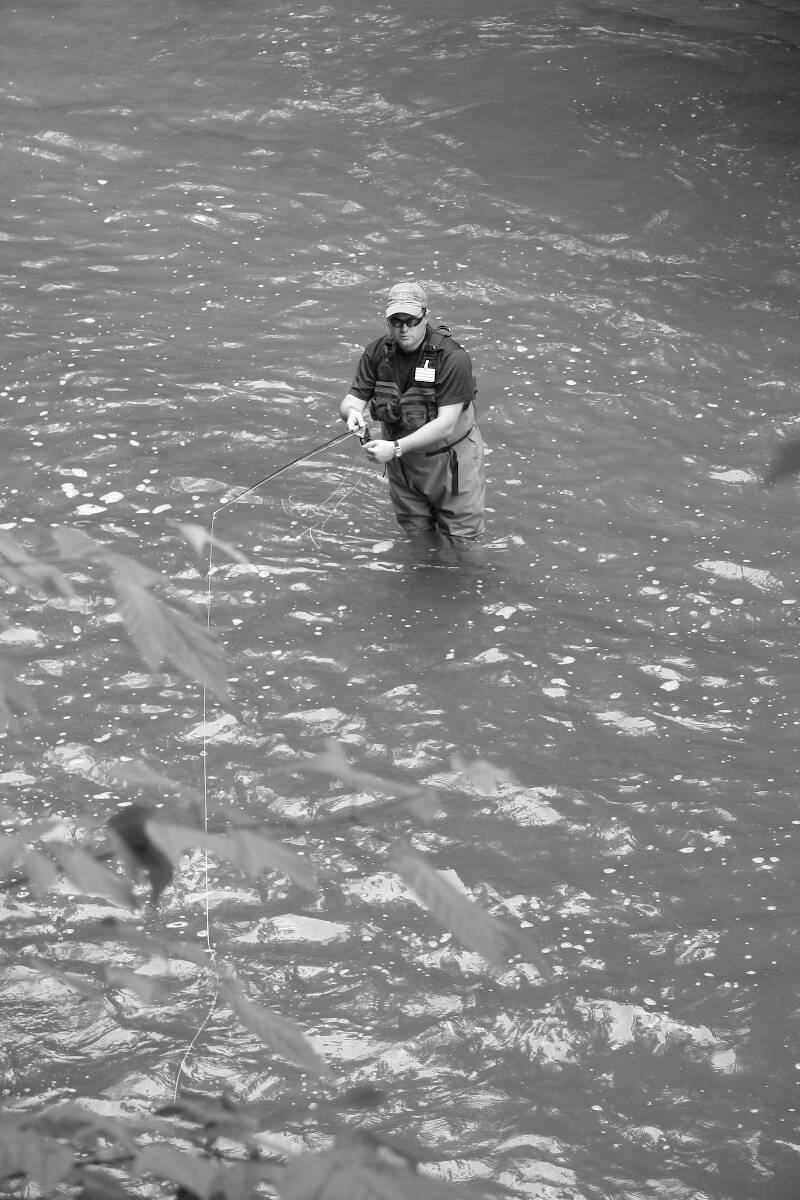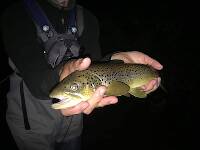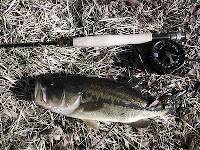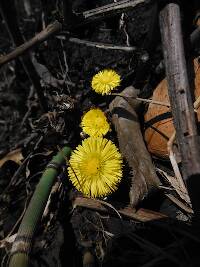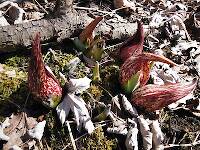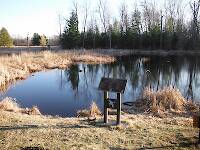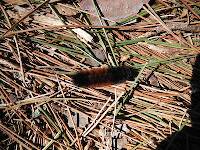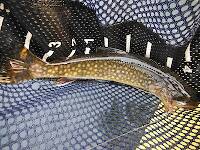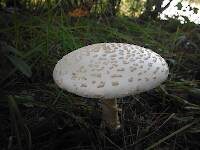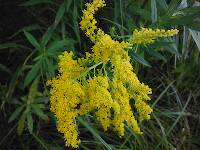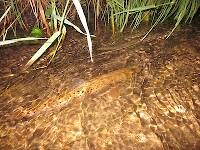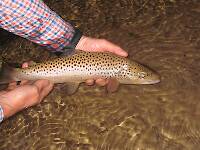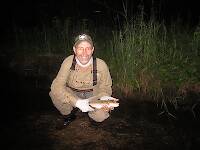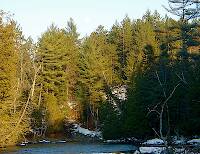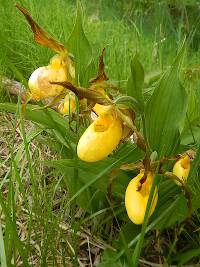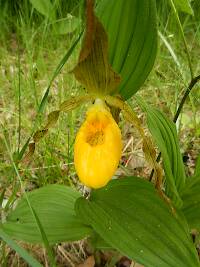
Hex Mayflies
Hexagenia limbata
The famous nocturnal Hex hatch of the Midwest (and a few other lucky locations) stirs to the surface mythically large brown trout that only touch streamers for the rest of the year.
Featured on the forum

I was not fishing, but happened to be at an unrelated social event on a hill above this tiny creek (which I never even saw) when this stonefly flew by me. I assume it came from there. Some key characteristics are tricky to follow, but process of elimination ultimately led me to Sweltsa borealis. It is reassuringly similar to this specimen posted by Bob Newell years ago. It is also so strikingly similar to this nymph from the same river system that I'm comfortable identifying that nymph from this adult. I was especially pleased with the closeup photo of four mites parasitizing this one.

Troutnut is a project started in 2003 by salmonid ecologist Jason "Troutnut" Neuswanger to help anglers and
fly tyers unabashedly embrace the entomological side of the sport. Learn more about Troutnut or
support the project for an enhanced experience here.
Windknot79 on Jul 19, 2010July 19th, 2010, 1:42 pm EDT
I have a pool where there are this big fish.A lot of people beat the water in the day for them and I have never seen anyone or did I hear of anyone hooking up on one.I was thinking of a night run to see if they would feed.
My question is has anyone fished at night for trout with any success?If so what patterns do u think I should try.The fish are all browns on a small stream in southern new york.thank u for any input mike.
My question is has anyone fished at night for trout with any success?If so what patterns do u think I should try.The fish are all browns on a small stream in southern new york.thank u for any input mike.
Dryfly on Jul 19, 2010July 19th, 2010, 2:25 pm EDT
Try a mouse, wake it through and hang on.
Windknot79 on Jul 19, 2010July 19th, 2010, 3:31 pm EDT
dryfly I was thinking the same thing.also was thinking maybe a big wooly bugger in black.I will try wendesday and let u know.
Jmd123 on Jul 19, 2010July 19th, 2010, 3:57 pm EDT
Windknot, there is a strong tradition of fishing for big browns after dark here in Michigan. The best time of the year is, of course, when the Hexagenia limbata are hatching, though the Light Cahill (Stenonema sp. I believe, just in case you know some entomology) is also a favorite of mine for dusk-into-dark fishing (for which a White Wulff, #10-12, works perfectly). If you are lacking a hatch and still want to try dry flies, tie on a big attractor like a #6 Royal Wulff or maybe a big katydid imitation (tie a big #6 or #4 grasshopper in ALL GREEN) and whip it around after dark over good-looking spots. Be ready for a BIG SPLASH!!!
Or, a Woolly Bugger (all black is just fine, along with brown and olive - I tie mine with grizzly hackle)) or maybe a baitfish imitation (fished "crippled" - erratic motion to look like it's sick) would arose a big brownie's appetite. Crayfish imitations perhaps? They are very active at night...
Good luck and let us know if you hammer any big dudes.
Jonathon
Or, a Woolly Bugger (all black is just fine, along with brown and olive - I tie mine with grizzly hackle)) or maybe a baitfish imitation (fished "crippled" - erratic motion to look like it's sick) would arose a big brownie's appetite. Crayfish imitations perhaps? They are very active at night...
Good luck and let us know if you hammer any big dudes.
Jonathon
No matter how big the one you just caught is, there's always a bigger one out there somewhere...
Jmd123 on Jul 19, 2010July 19th, 2010, 3:57 pm EDT
P.S. Take a good, but not TOO bright, flashlight, and lots of bug repellent!
Jonathon
Jonathon
No matter how big the one you just caught is, there's always a bigger one out there somewhere...
Flatstick96 on Jul 20, 2010July 20th, 2010, 4:22 am EDT
The first time you have a big trout hit your fly in the dark, it'll startle you. But it's awesome...
As to flies, you've had a bunch of good suggestions here - main thing, for me, is to go big.
Saw a special on TV one time where George Harvey was talking about some kick-ass night fly he used to tie, but I don't know the recipe for it - maybe someone else here does...
As to flies, you've had a bunch of good suggestions here - main thing, for me, is to go big.
Saw a special on TV one time where George Harvey was talking about some kick-ass night fly he used to tie, but I don't know the recipe for it - maybe someone else here does...
Flatstick96 on Jul 20, 2010July 20th, 2010, 4:42 am EDT
Here is an article about central PA night fishing:
http://www.post-gazette.com/pg/04179/338095.stm
And here is a copy-and-paste from one of Steve's posts on the FFP board, describing the Harvey night fly:
The Harvey Night Fly should be viewed as a style of fly, rather than a specific pattern. Basically, it is tied like so:
Hook: Mustad #36890, #1/0-6
Thread: 6/0
Tails: Hackle fibers, soft, short, and heavy
Hackle: Palmered over body
Body: Heavily dubbed. On a fly of this size, it is more practical to use a fuzzy yarn.
Cheeks (pectoral fins): Stiff breast feathers, mounted with natural curvature outwards.
When I night fished semi-seriously, I tied this fly in many colors. Basic all-black turned out to be the best. Turkey breast feathers make an excellent cheek material. The stiff breast feather cheeks send out strong underwater vibrations, drawing the trout to it. In fact, when you swing the fly, it feels like you have hooked a small fish.
We do not sell this fly.
Steve
http://www.post-gazette.com/pg/04179/338095.stm
And here is a copy-and-paste from one of Steve's posts on the FFP board, describing the Harvey night fly:
The Harvey Night Fly should be viewed as a style of fly, rather than a specific pattern. Basically, it is tied like so:
Hook: Mustad #36890, #1/0-6
Thread: 6/0
Tails: Hackle fibers, soft, short, and heavy
Hackle: Palmered over body
Body: Heavily dubbed. On a fly of this size, it is more practical to use a fuzzy yarn.
Cheeks (pectoral fins): Stiff breast feathers, mounted with natural curvature outwards.
When I night fished semi-seriously, I tied this fly in many colors. Basic all-black turned out to be the best. Turkey breast feathers make an excellent cheek material. The stiff breast feather cheeks send out strong underwater vibrations, drawing the trout to it. In fact, when you swing the fly, it feels like you have hooked a small fish.
We do not sell this fly.
Steve
GONZO on Jul 20, 2010July 20th, 2010, 5:35 am EDT
Mike,
The advice about flies is good (Harvey's Night Fly is a PA classic), but carefully planning your approach can be equally important at night, especially on smaller streams. If the pool in question has a broad, shallow tailout, don't automatically assume that the big fish will be holding in the depth and cover of the main pool after dark. Big fish make extensive forays into the shallows to feed under the cover of darkness (sometimes in water that barely covers their backs), and stepping into the shallow tail after dark might ruin your chances of catching a big fish.
The advice about flies is good (Harvey's Night Fly is a PA classic), but carefully planning your approach can be equally important at night, especially on smaller streams. If the pool in question has a broad, shallow tailout, don't automatically assume that the big fish will be holding in the depth and cover of the main pool after dark. Big fish make extensive forays into the shallows to feed under the cover of darkness (sometimes in water that barely covers their backs), and stepping into the shallow tail after dark might ruin your chances of catching a big fish.
Flatstick96 on Jul 20, 2010July 20th, 2010, 6:00 am EDT
Gonzo's point is certainly a good one, and it doesn't have to be pitch black, middle of the night fishing for it to hold true. Many times, just as dusk has settled into night, you'll find trout feeding like crazy in swift, shallow water (think barely deep enough to cover your ankles). The first fish you catch in water like that is surprising, but the surprise wears off when you catch several more in the same spot...
Windknot79 on Jul 20, 2010July 20th, 2010, 6:13 am EDT
This is all great info and will take it all in.I am trying to get out tomorrow afternoon in to the dark.One thing I am a custom to is night fishing.I do a lot of surf casting for stripers mostly in the dark. flagstick 96 thanks for the pattern I will try and tie it.
Gonzo I was thing the same thing about them moving out of the hole I will just try and work my way upstream and locate them.thank you everyone for the help and I will answer back with what happens.
Gonzo I was thing the same thing about them moving out of the hole I will just try and work my way upstream and locate them.thank you everyone for the help and I will answer back with what happens.
Flatstick96 on Jul 20, 2010July 20th, 2010, 8:37 am EDT
I remember seeing an interview with an old-timer (wanna say it was George Harvey again, but I could be very wrong on that) who said he used to employ the following method (details might be off because it's been probably 10 years since I saw said interview, but the gist is as follows):
1. Use a good flashlight to very slowly scan the water, looking for large, feeding trout.
2. When you locate one, turn off your light and wait a bit (5-10 minutes), then turn your light back on and shine it where you saw the fish.
3. If he's still there, turn your light back off, wait a couple more minutes, then present your fly to that spot.
4. Hold on!
1. Use a good flashlight to very slowly scan the water, looking for large, feeding trout.
2. When you locate one, turn off your light and wait a bit (5-10 minutes), then turn your light back on and shine it where you saw the fish.
3. If he's still there, turn your light back off, wait a couple more minutes, then present your fly to that spot.
4. Hold on!
Bobbyg on Jul 20, 2010July 20th, 2010, 10:07 am EDT
I would only add that you are sure of your footing in the dark.
Bob
Bob
"Many men go fishing all of their lives without knowing it is not fish they are after."
- Henry David Thoreau
- Henry David Thoreau
Jmd123 on Jul 20, 2010July 20th, 2010, 3:24 pm EDT
Actually, I try to determine fish location at night purely by listening, since I have found that shining any light on the water at night spooks fish. That's why I made a comment about having a light that was not too bright, and I always make a habit of turning my back to the stream when I turn it on to keep from shining it at the fish. Others may disagree, but bright light on the water at night is completely unnatural and I would avoid it if at all possible. Here in Michigan, for example, even moonlit nights are thought to be too bright during the Hex hatch - you want clouds or a night with a late-rising or new moon (and I ain't talkin' about vampires, folks).
Jonathon
Jonathon
No matter how big the one you just caught is, there's always a bigger one out there somewhere...
Flatstick96 on Jul 21, 2010July 21st, 2010, 2:51 am EDT
Yeah, I wasn't suggesting that I endorse or employ the practice, necessarily - just mentioning that I'd heard of it as a possibility...
Jmd123 on Jul 21, 2010July 21st, 2010, 5:51 pm EDT
I myself am wondering if these new LED fishing lights are too bright. The advice I got in my early Hex fishing days was not to use a flashlight with brand-new batteries, but one with rather old batteries so the light would be somewhat dim...
The other hazard of turning on a light at night on a trout stream is that you may soon have swarms of midges crawling up YOUR NOSE. One time on the Red Cedar River in East Lansing, MI I had to hold my breath when I turned on the light to avoid inhaling Light Cahills!
Jonathon
The other hazard of turning on a light at night on a trout stream is that you may soon have swarms of midges crawling up YOUR NOSE. One time on the Red Cedar River in East Lansing, MI I had to hold my breath when I turned on the light to avoid inhaling Light Cahills!
Jonathon
No matter how big the one you just caught is, there's always a bigger one out there somewhere...
Jmd123 on Jul 21, 2010July 21st, 2010, 5:54 pm EDT
P.S. One more piece of advice: fish this spot DURING THE DAYTIME so you know where all of the rocks, snags, sunken logs, etc. are so you neither spend your entire evening (morning??) snagging them or TRIPPING OVER THEM. Falling in the water face-first in the dark is considerably less pleasant than doing it in the daytime when at least you can see what exactly you just tripped over!
JMD
JMD
No matter how big the one you just caught is, there's always a bigger one out there somewhere...
Oldredbarn on Jul 22, 2010July 22nd, 2010, 3:52 am EDT
...and don't piss in the water after dark, aim it towards the brush...There are snapping turtles out there in the dark!
My advice is to just get your behinds home before dark like good little boys and don't stress your wives and leave the night-time to me :)...Fish don't feed after the sun sets anyways...Right? Right?
Spence
My advice is to just get your behinds home before dark like good little boys and don't stress your wives and leave the night-time to me :)...Fish don't feed after the sun sets anyways...Right? Right?
Spence
"Even when my best efforts fail it's a satisfying challenge, and that, after all, is the essence of fly fishing." -Chauncy Lively
"Envy not the man who lives beside the river, but the man the river flows through." Joseph T Heywood
"Envy not the man who lives beside the river, but the man the river flows through." Joseph T Heywood
Windknot79 on Jul 22, 2010July 22nd, 2010, 7:25 am EDT
well Spence I don't know if fish feed after dark,but I do know the sun hurts my eyes so I guess the night sift will work for me.
jmd123 I fish for stripers mainly at night and we put a red film in our light lens works great.It doesn't spoke the fish at all.the only thing is it throws the color of your flies off everything is red.
I couldn't get out last night we had some really bad storms move through.next week I will give it a try.Gives me time to get some flies together thanks guys for the info.
Mike
jmd123 I fish for stripers mainly at night and we put a red film in our light lens works great.It doesn't spoke the fish at all.the only thing is it throws the color of your flies off everything is red.
I couldn't get out last night we had some really bad storms move through.next week I will give it a try.Gives me time to get some flies together thanks guys for the info.
Mike
Jmd123 on Jul 22, 2010July 22nd, 2010, 8:10 am EDT
Mike, I use red flashlights as an amateur astronomer all the time - they don't ruin your night vision when you are trying to spot faint fuzzy things like galaxies and nebulae...
Yep, I'm a nerd, through and through.
Jonathon
Yep, I'm a nerd, through and through.
Jonathon
No matter how big the one you just caught is, there's always a bigger one out there somewhere...
JAD on Jul 23, 2010July 23rd, 2010, 12:11 pm EDT
Hi All
Some good advice on this post. I fished with a fellow who was very experienced at night fishing for Delaware browns. There are a couple things that have not been mentioned. Leaders- marking your line.
1. Leaders should be short ,made of Mason so their are very few tangles (12# test)with three droppers of 4 inches in long.
2. pre-fish area before in daylight as mentioned except mark length of cast by tying a small piece of string on fly line then clip cord close to fly line,at night you can feel the bump and that tell you the cast distance I have marked two three places on fly line different times, the next day you can trim the string off. As mentioned before my buddy would have kicked me in the ass if I would have shined a light when we were fishing let alone on the water,he trained me to walk a distance from the water then turn your back to the stream then to check leader or change flies.
Couple other things----large flies size 2 Cahills --BLK wooleybugger 2-inches long---2 inch Casual Dress .
Use a wading stall with rubber on bottom , no noise with staff or wading,be very quiet.(No studs)
Above All--- keep an eye out for the buggy man, he will be right behind you.
Have Fun
JAD---the other John
Some good advice on this post. I fished with a fellow who was very experienced at night fishing for Delaware browns. There are a couple things that have not been mentioned. Leaders- marking your line.
1. Leaders should be short ,made of Mason so their are very few tangles (12# test)with three droppers of 4 inches in long.
2. pre-fish area before in daylight as mentioned except mark length of cast by tying a small piece of string on fly line then clip cord close to fly line,at night you can feel the bump and that tell you the cast distance I have marked two three places on fly line different times, the next day you can trim the string off. As mentioned before my buddy would have kicked me in the ass if I would have shined a light when we were fishing let alone on the water,he trained me to walk a distance from the water then turn your back to the stream then to check leader or change flies.
Couple other things----large flies size 2 Cahills --BLK wooleybugger 2-inches long---2 inch Casual Dress .
Use a wading stall with rubber on bottom , no noise with staff or wading,be very quiet.(No studs)
Above All--- keep an eye out for the buggy man, he will be right behind you.
Have Fun
JAD---the other John
They fasten red (crimson red) wool around a hook, and fix onto the wool two feathers which grow under a cock’s wattles, and which in colour are like wax.
Radcliffe's Fishing from the Earliest Times,
Quick Reply
Related Discussions
Topic
Replies
Last Reply
4
Jul 28, 2015
by Jmd123
by Jmd123
1
Feb 10, 2010
by Oldredbarn
by Oldredbarn
0
May 25, 2012
by Jmd123
by Jmd123
1
Nov 18, 2007
by Martinlf
by Martinlf
3
Nov 23, 2018
by Brian314
by Brian314

